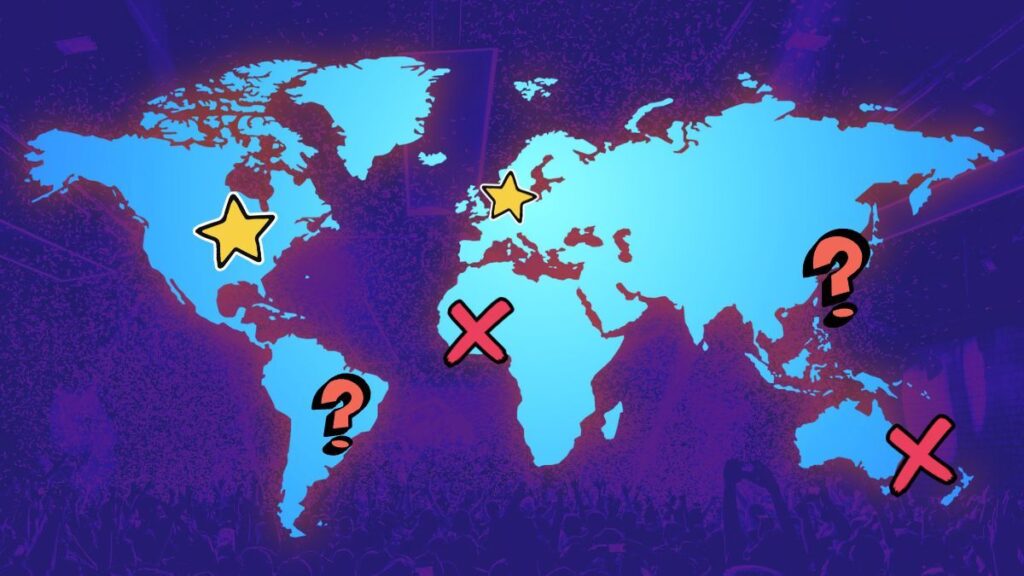The music business is more global than ever before. The interconnected nature of the digital age, rise of global charts, and streaming algorithms that exist beyond language barriers have all coalesced to increase the likelihood of an average listener encountering artists from far-reaching corners of the globe.
In 2024, Bad Bunny was the third most-streamed artist on Spotify, while Bollywood singer Arijit Singh displaced Taylor Swift as the most-followed person on the platform. Four different K-pop acts landed No. 1 albums on the Billboard 200 chart last year. But as the world has begun to feel smaller in many positive ways, there is one place where we have to collectively get it together: When it comes to tours, words suddenly have very little meaning at all.
Is it a North American tour, or is it just a tour throughout the US? Is an act perhaps dipping into Toronto for one night without the possibility of hitting any other Canadian provinces, let alone Mexico? Similarly, can we really call something a world tour when the map really just looks like the below (at best)? New York, LA, and London is not a “world tour,” friends; that is simply a list of places where you’ll find an overpriced smoothie.
“World tour” #memes https://t.co/QSOc1FY6Fb pic.twitter.com/FNj8kQg8rN
— Trackify for Spotify (@TrackifySpotify) April 8, 2023
Naturally, this critique is never targeted to small bands, emerging bands, or bands trying their very best to hit diverse markets. Touring is unbelievably difficult for bands under a certain financial threshold (just look at our Balance Sheet series, where artists break down costs of being on the road, for proof of that). But we’re talking about the heavy-hitters, the people backed by major labels, and the artists with the support of some very deep pockets. Anyone who has ever broken down a budget specifically for pyrotechnics or had a private chef on retainer for a tour doesn’t get to tell us that figuring out a show or two in Latin America is too complicated.
But for those who have the means, let’s start thinking a little more creatively about how a world tour can look or feel. Coldplay provided a strong example when their “Music of the Spheres” jaunt became the first rock tour – and second tour ever — to gross over $1 billion. It’s one of the more expansive world tours in recent years, but whatever the band is doing is working for both their bottom line and their fans. Since launching in 2022, the enormous trek has taken the group to South America with visits to Colombia, Chile, Peru, Brazil, and Argentina. They touched down in multiple countries in Europe that are too often overlooked, including Belgium, Poland, Denmark, and Wales. The band spent extensive time in Asia and Oceania; then, their show in India broke the record for the largest stadium show of the 21st century.
Similarly, while there are still some parts of the globe that weren’t impacted by “The Eras Tour,” Taylor Swift’s tour map is more colorful than many others. Again, not everyone has the resources offered to folks like Coldplay or Swift, but the success of both tours proves that expanding market horizons often yields positive results for everyone involved. Fans are happy. Artists are happy. Labels, promoters, and investors are happy.
Pre-pandemic feels like a distant world sometimes, but consider, too, the groundwork laid by BTS, before K-pop became the well-known entity it is today. The band was the first K-pop act to tour South America (their 2017 show in Chile sold out in a record-breaking two hours, before promoters even had a chance to start advertising). Today, acts like Stray Kids and Ateez are embracing global opportunities in their respective ascents; Stray Kids are set to hit Chile, Brazil, and Peru on their recently expanded “dominATE” tour. Meanwhile, Ateez are currently in the midst of giving European fans plenty of chances to witness a live show with stops in cities like Zurich, Cologne, and Brussles, and the eight-member team was also the first K-pop act to perform at Mawazine in Morocco, the second-largest music festival in the world and premiere music festival in Africa.
As it’s been, the “world” in “world tour” has been doing more heavy lifting than the dedicated crew members hauling equipment in and out of venues. For acts of a certain size, if you build it (a well-mapped tour offering fans in different demographics), they will come (see and enjoy the show). In the meantime, if you’re only hitting the US and a handful of other cities, do us all a favor. Just call it a 2025 tour.

